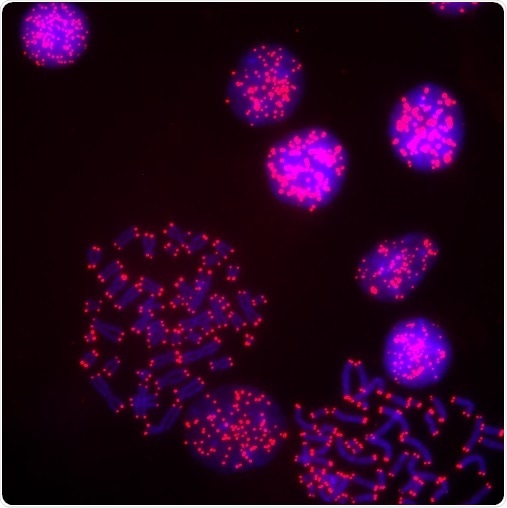Mar 27 2019
Scientists at Johns Hopkins say they have found that people born with abnormally short chromosome endcaps, or telomeres, have immune system cells that age and die prematurely. Their short-lived immune system cells also share some of the same characteristics of immune cells in much older people without the telomere disorder.

Image of human telomeres in cells. Each telomere is shown by red dots in resting nuclei of cells (circles) and cells that are dividing (separated linear chromosomes). Credit: Mary Armanios
Telomeres protect genetic information within chromosomes. As people age, telomeres of all cells wear away and shrink, limiting the cells’ ability to divide and multiply. However, some people are born with abnormally short telomeres, which may cause bone marrow problems and lung disease later in life.
Our research provides evidence that short telomere length can cause a variety of conditions, including immune system abnormalities, in addition to bone marrow problems and lung disease.”
Mary Armanios, M.D., Professor of Oncology at the Johns Hopkins Kimmel Cancer Center and Clinical Director of the Telomere Center at Johns Hopkins
For the study, described in the December 2018 issue of The Journal of Clinical Investigation, Armanios looked to information collected for a study she began in 2005 to understand diseases caused by short telomeres. Among 28 people younger than 60 who had abnormally short telomeres and who were born with mutations in the components that regulate telomere length, she noticed that nine of them had developed infections that are more commonly seen in people with damaged immune systems, such as those who receive certain types of cancer therapies. All nine people who had developed the infections and eight of 17 other people with short telomeres had abnormally low numbers of T-cells, which are part of the immune system.
T-cells recognize and remember invaders, such as viruses, and trigger defenses quickly when they try to infect the body again. Faulty or low numbers of T-cells can put people at higher risk for infections and make it more difficult for the immune system to rid the body of the infections.
Armanios and her colleagues examined T-cells in 16 young people (average age 21) with short telomeres, including some of the nine patients from the 2005 study who developed infections. They compared these T-cells to those in 18 young people with normal telomeres and 12 older adults whose telomeres had shortened naturally with age and were an average of 73 years old.
In the three groups, the researchers looked at how many T-cells were recently made in the thymus, a gland that sits in the middle of the chest and makes new T-cells for fighting newly encountered infections. Young people with short telomeres and the older adults pumped out half of the number of these new T-cells that young people with normal telomeres produced.
In addition, young people with short telomeres and older adults had fewer T-cells able to recognize foreign substances called antigens, including 23 of the most common ones. Also, when their T-cells were chemically stimulated in the laboratory to mount an immune response, many of the cells died rather than lined up to attack.
“The T-cells of young people with short telomeres looked more like the T-cells of people 50 years older,” says Armanios.
Despite the similarities between T-cells of young people with short telomeres and those of older healthy people, Armanios and her colleagues found some differences in the T-cells between the two groups.
When the researchers compared T-cell gene expression among the two groups, the researchers found differences in the way their T-cells were prone to die.
Armanios said:
A balance between survival and death programs in T-cells is needed for a healthy immune response, as well as for preventing cells from over-activation and attacking other antigens indiscriminately.”
Young people with short telomeres had T-cells with more gene expression of cell death signals linked directly to damaged telomeres. Older healthy people had T-cells with a different type of cell death signal: higher levels of cell-surface proteins known as programmed cell death 1 (PD-1).
Armanios says that the differences between how T-cells die in the two groups suggests that short telomeres may not be the sole cause of T-cell aging. “This result paints a rich picture about the variety of molecular causes of aging in different individuals and suggests that mechanisms in addition to telomere shortening contribute to T-cell aging,” Armanios says.